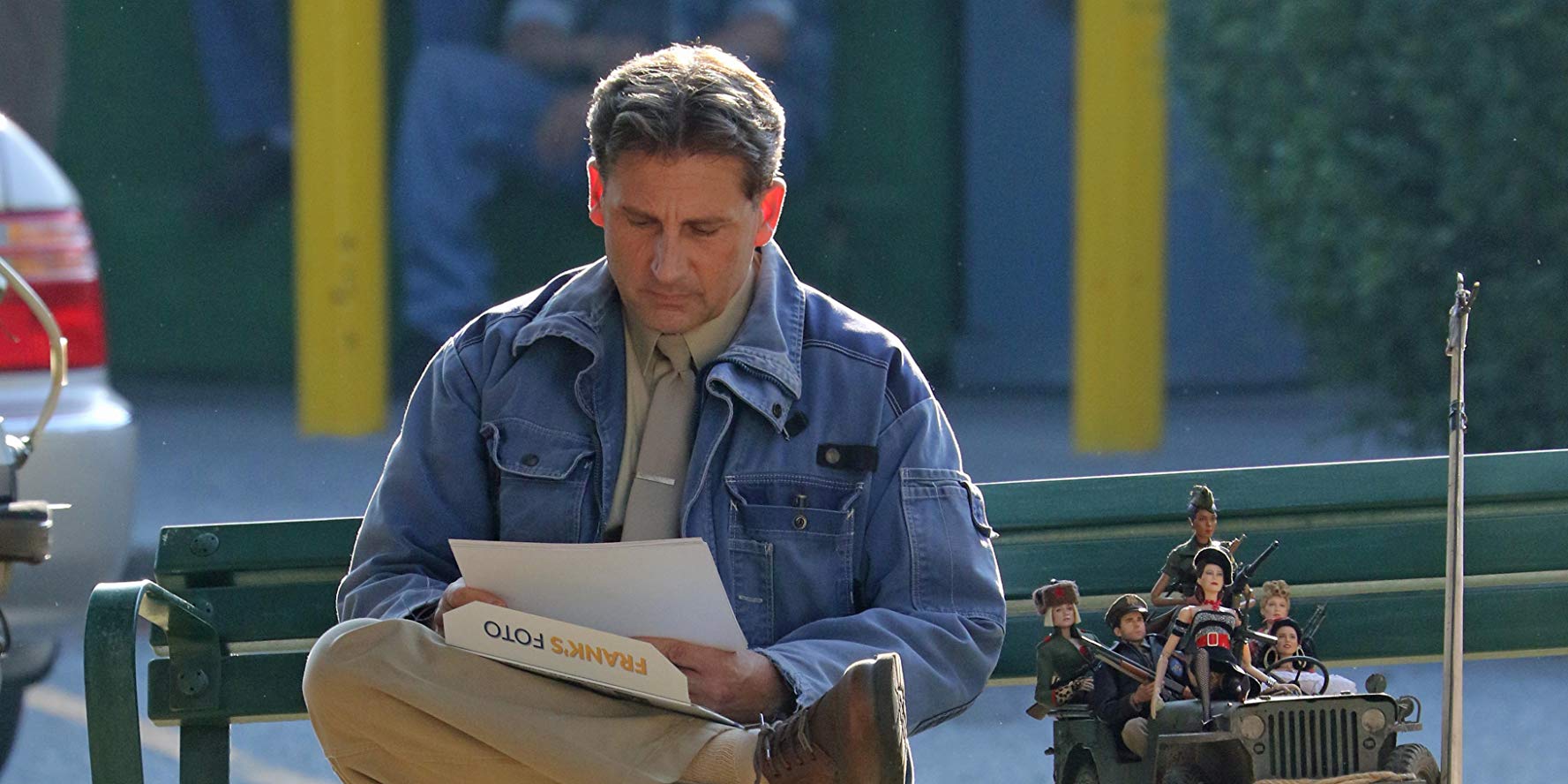Movie Info
Movie Info
- Director
- Robert Zemeckis
- Run Time
- 1 hour and 56 minutes
- Rating
- PG-13
VP Content Ratings
- Violence
- 3/10
- Language
- 2/10
- Sex & Nudity
- 1/10
- Star Rating
Relevant Quotes
Fear and trembling come upon me, and horror overwhelms me.
Bear one another’s burdens, and in this way you will fulfill the law of Christ.

The psalmist could be describing the aftermath of a severe beating inflicted upon comic book artist Mark Hogancamp (Steve Carrell) in April 2000. By way of background, which gradually comes out as the film develops, Robert Zemeckis and co-screenwriter Caroline Thompson based their film on a real-life person. In a Kingston, NY bar, the inebriated Mark Hogancamp blurted out that he liked to wear woman’s shoes, whereupon five men beat him so severely that he suffered a coma for over a week. After a month in the hospital and physical therapy he was able to walk once more but could no longer remember anything. Nor could he draw because his hands shook so much. He turned to photography, shooting imaginary WW 2 scenes acted out by dolls and action figures in a miniature village that he built adjacent to his small house. As he explains, “I was beaten up because I was different, so I’ve built a place where I can heal.”
Thus, the film opens during Mark’s coping with the horrific pain of his disability. Mark becomes WW 2 ace Capt. Hogie piloting his Flying Tiger P-40 over Belgian (yes, this is in Europe, not China) when he is brought down by anti-aircraft fire. He crash-lands and, his boots ruined, finds a pair of women’s shoes to replace them. (His justification for subsequent behavior—which he refuses to call his preference a “fetish”?) Nazi soldiers pop up from the road-side bushes, ready to shoot him, but they are cut down by intense fire from a group of women combatants sporting provocative outfits, combative attitudes, and lethal weapons to back up the latter. They retire together to the town of Marwen (the name contains part of “Mark” and “Wendy,” eventually becoming “Marwencol”, adding “col” for “Collette”) to celebrate their victory.
The illusion is dispelled when Mark himself appears with his SLR camera taking pictures of his dolls in the buildings or in their Jeep. He clings so closely to his escapist tales that he tows the large toy jeep, filled with his dolls, wherever he goes—to the restaurant where he works in the kitchen, the hobby shop where he obtains his dolls, and even to the bar where he had been assailed. It is a credit to the townsfolk that they all support him in his fantasies, especially Roberta (Merritt Wever) at the hobby shop, whom we quickly see is sweet on him. Mark, however, largely ignores her, his attention focused on the lovely woman who has just moved in across the street from him, Nicol (Leslie Mann).
The plastic women fighters have their counterpart in the real world—G.I. Julie (Janelle Monáe), his caretaker; Anna (Gwendoline Christie), his physical therapist; and porn star Suzette (Leslie Zemeckis). A plastic replica of Nicol soon joins them in his adventures. In addition to his fantasy women who come to his aid against his Nazi antagonists (who, of course represent the toughs who beat him up at the bar), there is Deja Thoris (Diane Kruger), a blue-haired witch who torments him almost as much as the Nazis. For a clue to her real-world reference, check the color of the capsules he is taking to maintain mental stability.
This stability is threatened by anything around him that might trigger a memory of the horrific attacks. Thus, his coming court appearance at which his assailants are to be sentenced is something he dreads. Also, on his schedule is the Manhattan opening of an exhibitions of the village photos he has been taking. His growing bond with Nicol, who visits him frequently gives him hope for a brighter future, despite what happens at the court sentencing, but is he mixing up neighborly concern and compassion for romantic feelings?
The film is an engrossing study of human resiliency and creativity coping with a terrible trauma. Although there are evil and destructive people, the film affirms, there are also humans who are caring and supportive. The way the various villagers look out for and encourage Mark reminds me of the good people in Lars and the Real Girl, who come to the aid of the mentally disturbed Lars when he starts going around with a life-sized inflated sex doll. We are social creatures, and not just isolated individuals, and thus our healing can be greatly enhanced by those around us. Mark is more fortunate than he realizes. During his road to some form of a recovery he is too focused on himself to realize this. We can hope that he will come to know this, as well as to take up the offer of romance he has overlooked.
The fantasy combat scenes may contain too much violence for some, but upon reflection, it should be realized that these are the fantasies of a disturbed man who has suffered from the intense hatred of a gang as vicious as the Nazis. If his disturbed mind is ever fully healed, he might be able to reach out to the soul-sick assailants with the forgiveness that so distinguishes the members of Emanuel AME church who forgave the murderer of their loved ones. This is a film that religious groups might want to add to their list of “must see and discuss” movies.
This review will be in the January issue of VP along with a set of questions for reflection and/or discussion. If you have found reviews on this site helpful, please consider purchasing a subscription or individual issue in The Store.

